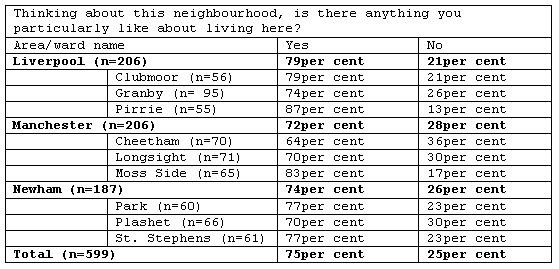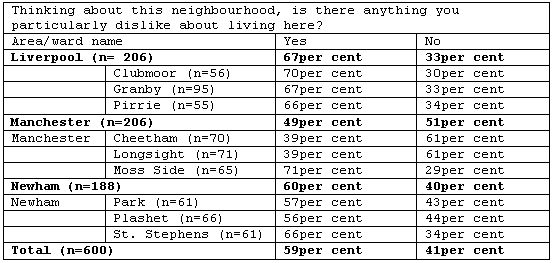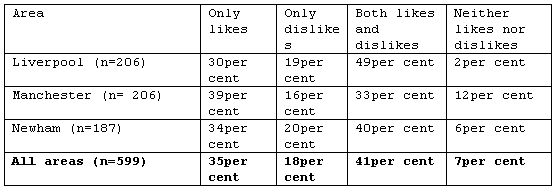
Thomas Scharf, Chris Phillipson and Allison Smith (2003) 'Older Peopleís Perceptions of the Neighbourhood: Evidence from Socially Deprived Urban Areas'
Sociological Research Online, vol. 8, no. 4, <http://www.socresonline.org.uk/8/4/scharf.html>
To cite articles published in Sociological Research Online, please reference the above information and include paragraph numbers if necessary
Received: 17/11/2003 Accepted: 17/11/2003 Published: 28/11/2003
 Abstract
Abstract Introduction
IntroductionSpace has (...) a major role in the integration or segregation of urban society. It is a manifestation of social relationships, while affecting and shaping the geometries of these relationships. This leads to the argument that social exclusion cannot be studied without also looking at spatial segregation and exclusion. Social cohesion or exclusion, therefore, are indeed socio-spatial phenomena....
Neighbourhood has become more than a source of security, the base of a supportive network, as it has long been: it has become a source of identity, a definition of who a person is and where he or she belongs in society.
Selective intensification of feelings about spaces may be far more than merely the coincidental outcome of lengthy residence in a single setting. It is postulated that it represents a universal strategy employed by older people to facilitate maintaining a sense of identity within a changing environment.
 Methodology
Methodology Findings
Findings| Table 1. Older people identifying positive aspects of their neighbourhood |

|
'[T]he neighbours are good. You know, the chap over the road takes my bin out if I'm not there and brings it back for me. I've seen him this morning, talked to him. And the lady next door - if I'm going to Asda or anywhere and I'll be late, she keeps .... We've all got keys.' (79-year-old white woman, Pirrie)
'The good thing about living here, I would say, is that there is a Pakistani community here. So you can easily make friends with neighbours and community members.' (Pakistani man, Longsight)
'I went out shopping this morning along the bungalows, and a lady was coming along and she said 'good morning'. And I've never seen her before in my life. People are friendly. The majority of them are.' (81-year-old white woman, Plashet)
'[E]verything's here. It's really convenient, you know. Everything's not very far away. I mean, it'd be different, say, if you lived in a country place. It might be, I don't know.... But here, as I say, it's only 10 minutes walk from here to the Post Office and you can get all the services you want there.' (84-year-old white man, Granby)
'I find that Stratford is good because I can walk to Stratford, do my shopping, walk home and don't have to worry about buses. I can get to Ilford from here. I can get to Romford from here. And if you're aged you get a bus pass in Newham. You don't get it everywhere. And yeah, I think, you know, we've got the Theatre Royal which they're doing up. We've got a cinema. The station is quite near; you can get to most anywhere from Stratford Station. I like living here.' (65-year-old white woman, Park)
'It's good, in the sense that you have all your shops here and the mosque is nearby. You are also with your own people. But then again, I don't know any different. But the main thing is that there are mosques nearby.' (Pakistani woman, Longsight)
'This area's very clean. For example, I don't know whether you noticed it, but down there they have a few bins and there's always ... every day there's a man goes along sweeping up.' (66-year-old white man, Park)
'I've no problems, if that's what you mean, you know. I don't have noisy neighbours. I don't have noisy kids. It's pretty tranquil down here, you know. They call it sleepy valley, actually.' (72-year-old white man, Longsight)
'Compared to other areas in Liverpool, I mean, Toxteth gets a terrible name. But it's quite quiet. It's quite good. I mean, we've got no problems with violence - it's just that ... Well we just don't go out of a night - that's all.' (63-year-old white man, Granby)
'I mean, I go to them [community safety] meetings, so I know there's virtually no crime, not on this estate. We have a problem across the road - but here, no we don't. No, it's quite good here. So I like everything really.' (65-year-old white woman, Cheetham)
'The neighbourhood is quite good. No stealing, no pickpockets, no breaking and entering.' (64 year-old Black African man, Park)
'I mean, it's [local area], had a very, very bad name. But it's not as bad as they've pictured it, you know. That's the way they put it like, you know. I wouldn't live up there [neighbouring area], you know, it's bad. But I mean you can leave your car here.' (67-year-old white man, Granby)
| Table 2. Older people identifying negative aspects of their neighbourhood |

|
'The neighbourhood is in a real bad state. It looks awful and run down.' (Pakistani woman, Longsight)
'There are rodents, rats running around because of the empty houses, empty properties. We found rats roaming around [inside the house] and we called the council. ... These houses are too old and need to be demolished.' (Somali man, Granby)
'Well, the general appearance of the estate has deteriorated. Broken lamp standards and empty property.' (68-year-old white man, Cheetham)
'The streets are untidy. Well I was walking along this morning and I thought: "Filthy." All the bits and pieces in the road. And yet I saw the road sweeper across the road as I was going out. Oh it is dirty! It has really gone downhill, I think.' (81-year-old white woman, Plashet)
'Well, I used to take the dog for walks of a night. But there's that many kids around here. They're terrible the youths. They're not nice.' (63-year-old white woman, Clubmoor)
'Basically, I can only describe this area as an area that has been forgotten by the authority. It is an area where there are a lot of drugs and violence, and it seems the situation is getting worse in terms of drug dealing and also violence.' (Somali man, Granby)
'Because they don't own the property, they're not careful to make sure it looks good. So the gardens are neglected, the front curtains are, you know, not as they should be. ... It does kind of lower the appearance with the curtains not hanging right and ... the gardens not tidy and the fronts not swept, you know. So in that respect it makes the area look cheap and, you know - but it's just because the students... Well, to be honest, they probably don't even have time, but they don't even think of it anyway. They ... just open the door, go in and that's it and what's out the front doesn't matter, you know. They don't sweep the front or anything, you know.' (62-year-old Black Caribbean woman, Moss Side)
'Nearly all my white neighbours have gone. There aren't many of us [white people] down here now because they're nearly all Asians and what have you. All right, some of them are quite nice - some of them. I speak to them and I'm sociable to them, but you still feel as if you're being taken over, you know.' (75 year-old white woman, St Stephens).
'It's too many ethnics, I think. It's overdone. I'm not a racist, but I think it's too far, especially with the Borough. I mean, you couldn't complain about any ethnics - you'd just be evicted from your house if you started that sort of thing. But I mean it's wherever you go. I mean, you go to the council offices - they're ethnics. You go to the doctors - they're ethnics. They're all behind every desk and behind every counter round here. I mean, it's a bit much. The hospital's the same ... I mean they're all, you know, West Indians, Pakis or what have you. It's too much all at once, I think.' (85-year-old white man, St Stephens)
'[I]t is not safe if you leave your house. It might get broken in. In the early days, you used to able to go to the sea - six months, seven months - and you would leave your house empty and it will remain safe. I mean if you leave for half an hour now, you might come back and see they burgled the house.' (Somali man, Granby)
'The bad thing is that crime that is occurring in this area and ... You know that there was recently a shooting in the area too? It frightens me to think that my children will grow up in this kind of life. There is nothing for them here.' (Pakistani man, Longsight)
'There is so much vandalism in the area. I mean to say the bus shelters, at all the bus stops - they are forever coming down and putting new glass in. Because they are smashed, night after night, after night.' (73-year-old white woman, Plashet)
'You see, most of the people of my age now they're either dead or moved away. And the young people that are coming up now, they're not a bit sociable, because it's like the older people are in their way. They have no respect for us, no regard. Very few, you know. They're rude and obnoxious and even if you see them doing anything, no matter how young they are, and if you see them doing something that you think is not right you daren't speak to them because they'll give you a mouthful you know so .... They'll even throw bricks and stones at you, so it's best to leave them alone.' (69-year-old Black Caribbean woman, Moss Side)
'It has deteriorated a lot round here. Neighbours never speak.' (85-year-old white man, St Stephens)
'There used to be a sort of a clutch of people that felt as if they belonged. They'd worked together to keep the street clean or ... if you seen anybody else's bin at night, you'd push it through the gate and things like that, you know. And anybody in trouble, you'd go to see. But there's not that many people you know so well now because the whole ... population has changed. I mean this whole side of that road, down there, is all new people, and we speak to them and they're very nice - but we don't know them.' (65-year-old white woman, Cheetham).
'That's why we don't know anyone, because they're coming and going. They change. They're just hopping from one house to another and we don't really know a lot of people in the street now. As I say, we've lived here 38 years. But they're in transit aren't they? They just live there, then go.' (63-year-old white man, Granby).
Neighbours moved away or died and newcomers 'don't want to have anything to do with old people.' They talk to you in the street but they shun you. You can notice it. People just don't seem to be so friendly. These youngsters have got no time for old people. People bemoaned the loss of familiar faces.

|
| Table 3. Older people's expression of likes and dislikes about the neighbourhood |
 Conclusion
Conclusion
 Acknowledgements
Acknowledgements
BURROWS, R. and RHODES, D. (1998) Unpopular Places. Bristol: Policy Press.
CATTELL, V. and EVANS, M. (1999) Neighbourhood Images in East London: Social Capital and Social Networks on Two East London Estates. York: Joseph Rowntree Foundation.
DETR (1998) Updating and Revising the Index of Local Deprivation. Department of the Environment, Transport and the Regions: HMSO.
GLENNERSTER, H., LUPTON, R., NODEN, P. and POWER, A. (1999) Poverty, Social Exclusion and Neighbourhood: Studying the Area Bases. CASE paper 22, London: Centre for Analysis of Social Exclusion, London School of Economics.
HILLS, J. (1998) Income and Wealth: the Latest Evidence. York: Joseph Rowntree Foundation.
HILLS, J., LE GRAND, J. and PIACHAUD, D. (editors) (2002) Understanding Social Exclusion. Oxford: Oxford University Press.
LUPTON, R. (2001) Places Apart? The Initial Report of CASE's Areas Study. London: Centre for Analysis of Social Exclusion, London School of Economics.
MADANIPOUR, A., CARS, G. and ALLEN, J. (editors) (1998) Social Exclusion in European Cities: Processes, Experiences, and Responses. London: Jessica Kingsley.
MARCUSE, P. (1996) 'Space and Race in the Post-Fordist city', in E. Mingione (editor), Urban Poverty and the Underclass: A Reader. Oxford: Blackwell.
PHILLIPSON, C., BERNARD, M., PHILLIPS, J. and OGG, J. (1999) 'Older People's Experiences of Community Life: Patterns of Neighbouring in Three Urban Areas', Sociological Review, Vol. 47, No. 4, pp. 715-743.
PHILLIPSON, C., BERNARD, M., PHILLIPS, J. and OGG, J. (2001) The Family and Community Life of Older People. London: Routledge.
POWELL, M., BOYNE, G., and ASHWORTH, R. (2001) 'Towards a Geography of People Poverty and Place Poverty', Policy and Politics, Vol. 29, No. 3, pp. 243-258.
POWER, A. (2000) Poor Areas and Social Exclusion. CASE paper 35, London: Centre for Analysis of Social Exclusion, London School of Economics.
RAPHAEL, D., STEINMETZ, B. and RENWICK, R. (1999) The People, Places and Priorities of Lawrence Heights: Conclusions from the Community Quality of Life Project. Toronto: University of Toronto.
RISEBOROUGH, M. and SRIBJLANIN, A. (2000) Overlooked and Excluded? Older People and Regeneration: A Review of Policy and Practice. London: Age Concern.
ROGERS, R. and POWER, A. (2000) Cities for a Small Country. London: Faber.
ROWLES, G.D. (1978) Prisoners of Space? Exploring the Geographical Experience of Older People. Boulder: Westview.
ROWLES, G.D. and RAVDAL, H. (2002) 'Aging, Place, and Meaning in the Face of Changing Circumstances', in R.S. Weiss and S.A. Bass (editors) Challenges of the Third Age: Meaning and Purpose in Later Life. Oxford: Oxford University Press.
SCHARF, T., PHILLIPSON, C., KINGSTON, P. and SMITH, A.E. (2001) 'Social Exclusion and Older People: Exploring the Connections', Education and Ageing, Vol. 16, No. 3, pp. 303-320.
SCHARF, T., PHILLIPSON, C., SMITH, A.E. and KINGSTON, P. (2002) Growing Older in Socially Deprived Areas: Social Exclusion in Later Life. London: Help the Aged.
SMITH, A.E. (2000) 'Quality of Life: A Review', Education and Ageing, Vol. 15, No. 3, pp. 419-35.
SOCIAL EXCLUSION UNIT (1998) Bringing Britain Together: A National Strategy for Neighbourhood Renewal. Social Exclusion Unit, London: HMSO.
SOCIAL EXCLUSION UNIT (2001) A New Commitment to Neighbourhood Renewal: National Strategy Action Plan. Social Exclusion Unit, London: HMSO.
TOWNSEND, P. (1963) The Family Life of Old People: An Enquiry in East London. London: Pelican.
YOUNG, M. and WILLMOTT, P. (1957) Family and Kinship in East London. Harmondsworth: Routledge.